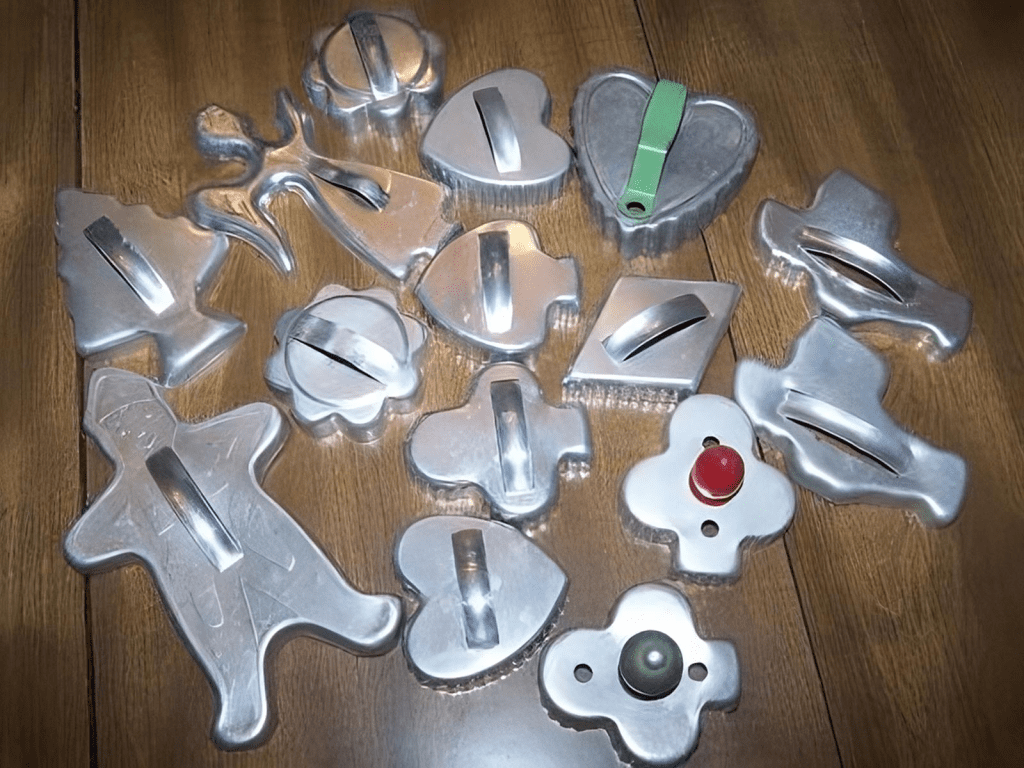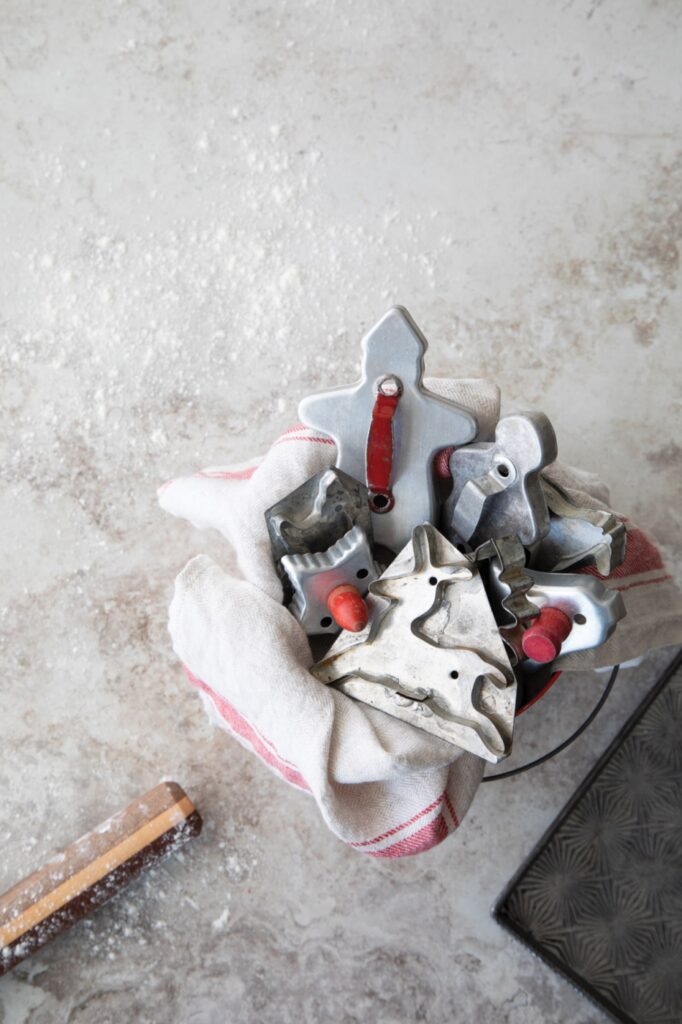Cookie cutters have a special place in our hearts, bringing back fond memories of holiday baking marathons with flour-dusted kitchens and the thrill of creating playful shapes in dough. Whether you’re nostalgic for vintage tin cutters passed down through generations or exploring modern designs, cookie cutters have a rich history and charm that continue to delight bakers of all ages. Let’s explore the fascinating journey of cookie cutters, from their origins to their role in holiday traditions, and the collectors who cherish these shape-makers today.
A Brief History of Cookie Cutters

While shaped pastries and cakes date back to ancient Egypt, the cookie cutters we know and love today likely originated in Italy before the 1400s. By the 1500s, they were already popular across Europe, especially in the United Kingdom. These early “imprint cutters” not only cut the shape but also pressed designs into the dough, adding a decorative touch to baked goods.
Early cookie cutters, known as “biscuit cutters” outside the United States, were often carved from wood. This tradition was particularly popular in Germany’s Black Forest region, where elaborate hand-carved molds became a staple in holiday baking. German and Dutch immigrants brought these traditions to the American colonies, and Pennsylvania became known for its abundant holiday cookie production and ornately carved molds. However, as bakers realized metal’s advantages over wood for cutting dough, thin strips of tin and copper became the materials of choice by the early 1700s.
The Evolution of Cookie Cutters in America
In Colonial America, tin was hard to come by, as England controlled production and restricted access to this valuable material. As a result, early American cookie cutters were meticulously fashioned from tin scraps, with flat backs to conserve every inch of metal. Cookie cutters with handles didn’t appear until after the Revolutionary War, as materials became more accessible.
By the mid-19th century, metal cookie cutters were being mass-produced in the United States, with tin giving way to aluminum by the 1930s. Around this time, plastic cutters also started appearing, adding colorful options to the baker’s toolkit. Today, cookie cutter shapes span every imaginable theme, from animals to holiday symbols and beyond, especially with the rise of 3D printing, which allows for endless customization.
The Holiday Connection: Cookie Cutters in Winter Traditions
For many families, cookie cutters are synonymous with winter holidays. Shapes like Christmas trees, stars, gingerbread men, and reindeer have become staples of holiday baking traditions. The seasonal excitement of selecting and pressing out these shapes turns cookie baking into an event, making memories just as sweet as the treats themselves.
In some families, cookie cutters are heirlooms, passed down through generations. These vintage cutters, often made of tin or aluminum, carry with them memories of past holidays. The charm of the vintage reindeer cookie cutter, for example, lies in its tendency to break or bend—a “flaw” that often led to a few extra bites during baking sessions.
Collecting Cookie Cutters: From Hobby to Passion
Cookie cutters are often more sentimental than valuable, but that hasn’t stopped people from collecting them. Collectors enjoy the endless variety of shapes, materials, and designs that tell the story of baking history. Many enthusiasts belong to the Cookie Cutter Collectors Club, a group dedicated to the appreciation and preservation of these unique kitchen tools. The club oversees the National Cookie Cutter Historical Museum in Joplin, Missouri, where visitors can explore the evolution of cookie cutters through the decades.

Some collectors go to extraordinary lengths. One Minnesota collector has amassed a staggering 40,000 cutters, and others have found creative uses for their collections. Beyond cookies, these versatile tools shape sandwiches, rice, pizza, and even mashed potatoes—adding a bit of whimsy to every meal.
Unique Uses for Cookie Cutters Beyond Baking
While cookie cutters are traditionally used for shaping cookies, many bakers have discovered that their usefulness goes well beyond the cookie tray. Here are some creative ways to use cookie cutters:
- Sandwich Shapes: Perfect for kids’ lunches, cookie cutters can transform plain sandwiches into fun, inviting shapes, making mealtime more enjoyable.
- Fruit and Cheese Platters: Use cutters to create adorable shapes from melons, apples, or cheese slices for eye-catching party platters.
- Pancake Art: Pour batter into cookie cutters on a griddle to make pancakes in shapes that will thrill kids and adults alike.
- Holiday Crafts: With a little paint and ribbon, cookie cutters can double as holiday ornaments or gift tags.
- Candle Molds: Cookie cutters can even be used to make custom-shaped candles by pouring melted wax into the shapes, adding a homemade touch to holiday decor.
These versatile tools prove that cookie cutters are not just for cookies—they’re for creating memories, sparking creativity, and adding joy to everyday moments.
Vintage Cookie Cutters: A Slice of Nostalgia
Vintage cookie cutters, especially those crafted from tin or aluminum, have a unique charm that transports us back to a simpler time. These cutters often feature classic shapes and folk-art designs that reflect the aesthetic of past decades. Some cutters, crafted with lead-based solder, are no longer safe for use with food but remain valuable collectibles.

Collectors value vintage cutters for their history and character. Many are one-of-a-kind, showing signs of wear from decades of use in the kitchen. The slight imperfections and patina on these vintage tools add to their appeal, making each one a small piece of culinary history.
The Cookie Cutter’s Place in Modern Kitchens
Despite the influx of gadgets and technology in modern kitchens, cookie cutters remain a beloved baking tool. Their simplicity and nostalgic value make them a timeless accessory, whether you’re baking for the holidays or a simple weekend treat. With online stores and 3D printing, anyone can create custom cookie cutters for any occasion, blending tradition with creativity.
For some, cookie cutters are a creative outlet; for others, they’re an essential part of family traditions. Either way, these charming tools continue to bring people together, making ordinary ingredients like sugar, flour, and butter something magical.
Conclusion: The Timeless Appeal of Cookie Cutters
Cookie cutters are more than just baking tools—they’re a bridge between past and present, connecting generations through shared traditions and memories. From their origins in European kitchens to their role in today’s holiday celebrations, cookie cutters have carved out a special place in our hearts and homes. Whether you’re using a vintage tin cutter handed down through your family or a custom 3D-printed design, these delightful tools invite us to celebrate, create, and, above all, enjoy the simple pleasure of baking. So next time you dust off your favorite cookie cutter, remember that you’re continuing a tradition that’s as sweet and timeless as the cookies themselves.


